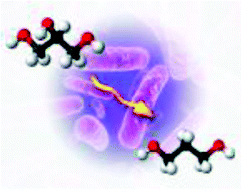Citrobacter werkmanii, a new candidate for the production of 1,3-propanediol: strain selection and carbon source optimization†
Abstract
In the past decade

* Corresponding authors
a
Centre of Expertise – Industrial Biotechnology and Biocatalysis, Department of Biochemical and Microbial Technology, Ghent University, Coupure Links 653, B-9000 Ghent, Belgium
E-mail:
Marjan.DeMey@UGent.be
Fax: +32 92 64 62 31
Tel: +32 92 64 60 28
In the past decade

 Please wait while we load your content...
Something went wrong. Try again?
Please wait while we load your content...
Something went wrong. Try again?
V. E. T. Maervoet, J. Beauprez, S. L. De Maeseneire, W. K. Soetaert and M. De Mey, Green Chem., 2012, 14, 2168 DOI: 10.1039/C2GC35369E
To request permission to reproduce material from this article, please go to the Copyright Clearance Center request page.
If you are an author contributing to an RSC publication, you do not need to request permission provided correct acknowledgement is given.
If you are the author of this article, you do not need to request permission to reproduce figures and diagrams provided correct acknowledgement is given. If you want to reproduce the whole article in a third-party publication (excluding your thesis/dissertation for which permission is not required) please go to the Copyright Clearance Center request page.
Read more about how to correctly acknowledge RSC content.
 Fetching data from CrossRef.
Fetching data from CrossRef.
This may take some time to load.
Loading related content
